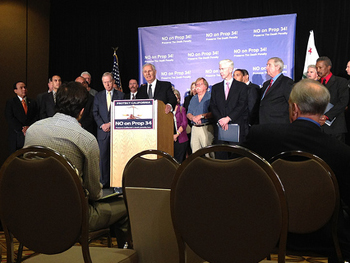By Kat Bouza
Listen to an audio story from Annenberg Radio News
Tim Bovard handles dead animals for a living.
Now, the very thought of that might make most of us squeamish. But Bovard isn’t like most of us — he’s the head taxidermist at the Natural History Museum of Los Angeles. When you ask him about his work, he’ll light up with an enthusiasm that your average adult would reserve for describing a relaxing vacation — not a life spent skinning lemurs that died in captivity, or bobcats hit by cars.
It doesn’t hurt that Bovard has practiced taxidermy for most of his life.
“My parents would have said that they think I was born with this in mind,” Bovard reveals. “As a kid, I was already trying to do things, find animals, try and preserve them. I actually mounted my first animal to try and do a realistic life mount…was when I was 9, 10 years old. And it was a skunk.”
Bovard grew up in Southern California, and his family would often visit the Natural History Museum. His love of the museum’s intricate dioramas fueled his interest in the taxidermy profession. “A lot of people become somewhat fascinated because you never get to see the muscular typically of animals because they’ve got the skin on,” Bovard admits, adding, “And there’s not as much blood and bad smells and stuff as one might think of.”
The taxidermy process is surprisingly simple. Animal specimens are measured to ensure a proper fit over a polyurethane form, then skinned. The skin is salted and placed into a solution for pickling. “Pickling is just like doing pickles,” Bovard explains. “It’s an acid and a salt…same idea, pickling solution, couple of days.”
I follow Bovard outside of his office to a workspace covered in machinery, large plastic barrels, and buckets full of salt and animal fat.
He leads me to one barrel tucked away in the corner of the workspace and removes the lid. It’s filled to the brim with a briny, murky brown liquid. Bovard plunges his hand inside the barrel and fishes around until he produces a large, sopping wet — but extremely beautiful cow’s hide.
Bovard lifts up the hide to show where the skin has been shade as he explains the process: “You can see some lines or ridges in it,” he says, indicating to marks on the underside of the hide. “And what I’ve been doing is shaving it down. So, removing any excess tissue or flesh, but also actually shaving the thickness of the hide down. “
When the animal’s skin reaches the desired thickness, it’s put into a tanning bath then rubbed with oil to ensure the hide won’t shrink. From there, the skin is glued to the form. Glass eyes and clay features, such as noses and footpads, finish out the mount.
The entire process can take one or two days for small animals and birds. A larger animal — like the cow Bovard is pickling — can take several weeks.
Los Angeles’ Natural History Museum is one of only several museums that still employs a full-time taxidermist. Most museums use dioramas created at the beginning of the 20th Century. So, the need for artisans like Bovard has dwindled with the passage of time.
“When they had most of their exhibits built, why did they need a taxidermist anymore?” he says. “In most cases, their exhibits were behind glass and sealed up, so when the taxidermist retired, often they weren’t replaced.”
“Some of our dioramas bays, instead of saying, being installed in the 20s and never touched since then, have had three, four…different sets of animals in them…to kind of update our story. That is a unique part of this institution.”
A skilled taxidermist is intimately familiar with everything from anatomy to sculpture.
But the real artistry in taxidermy, says Bovard, is bringing dead animals back to life.
“You know, we like live stuff too,” he jokes. “That’s sometimes intriguing to people who think we’re just into the dead stuff. And if you think about it, it makes sense. Yeah, we are working with a dead animal, but we are trying to make it back to what it looked like in life. And that is a challenge…To me, kind of the ultimate challenge is to take that dead animal and get it back and capture some of the essence, some of the beauty of that animal.”
If Bovard decides to retire, that doesn’t mean the taxidermy department of the Los Angeles Natural History Museum will disappear. Bovard is currently working with two apprentices, ensuring the art of taxidermy will live on.









 Former Governors Gray Davis, Pete Wilson and George Deukmejian gathered with victims’ families Tuesday in Downtown Los Angeles to gather last-minute support against abolishing the death penalty.
Former Governors Gray Davis, Pete Wilson and George Deukmejian gathered with victims’ families Tuesday in Downtown Los Angeles to gather last-minute support against abolishing the death penalty.




